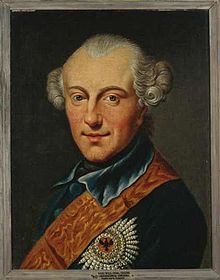(1735-1806) ruler of the duchy of Braunschweig-Wolfenbüttel from 1780 to 1806.
Marriage alliances linked the Braunschweig princes with PRUSSIA, thereby providing them with a powerful ally and protector. Karl Wilhelm Ferdinand exhibited interests as a young man in the intellectual trends of the ENLIGHTENMENT and in state reform. He studied the writings of the French PHILOSOPHES and traveled to Ferney to visit VOLTAIRE. He also read the German systematic, rational philosophers such as Gottfried Wilhelm LEIBNIZ and Christian WOLFF and writers of the AUFKLÄRUNG such as Gotthold Ephraim LESSING. Karl Wilhelm Ferdinand brought Lessing to his capital at Wolfenbüttel to serve as curator and librarian of the impressive (and still extant) ducal library.
As the ruler of Braunschweig-Wolfenbüttel, Karl Wilhelm Ferdinand earned an international reputation as an able, energetic, an enlightened leader. He instituted fiscal and educational reforms, improved the roads, liberalized restrictions on the press, and finally, although personally a Lutheran, practiced TOLERATION of the Jews.
Karl Wilhelm Ferdinand was also a skilled military commander who served in the Prussian army of FREDERICK II (THE GREAT). During the wars brought about by the FRENCH REVOLUTION, the French revolutionary government considered offering him the command of the French armies, but that plan never reached fruition. Instead, Karl Wilhelm Ferdinand, who had already been made a Prussian field marshal in 1787, headed the German armies when they launched their invasion of France in 1792. He was defeated at Valmy and resigned his command but resumed the command of the Prussian army in 1806. Karl Wilhelm Ferdinand’s troops were defeated by the French at Auerstädt, but he was mortally wounded during the battle on the very same day that Napoleon defeated another Prussian army unit at the battle of Jena. Karl Wilhelm Ferdinand died a few weeks later.
1. Musketeer, 25th regiment c.1790, 2. Fusilier c.1790 (in 1789 they wore green vests and breeches), 3. Grenadier, 6th regiment c.1768 (the last year of the mitre before being replaced by the Casket, 4. Grenadier in Kasket c.1790, 5. Line Grenadier c.1799 wearing the new style mitre adopted by the Guard in 1798, 6. Officer of Light infantry c.1790 Note: the double breasted turnbacks standardised in 1802-1803, 7. Standard of the 17th (Ansbach-Bayreuth) in 1795, 8. Standard of the 57th Line regiment in 1798.
Prussian The Infantry: pre 1806
Before 1806 the infantry comprised the Foot Guards, 52 line regiments (increasing to 54 in 1794, 55 in 1797, 56 in 1803 and 57 in 1804) and twenty fusilier (light infantry) battalions, rising to 21 in 1795 and 24 by 1806. Each regiment comprised one grenadier and two musketeer battalions plus a depot (becoming the 3rd Musketeer battalion in 1796, raised to full strength only on mobilization), each battalion of four companies of 155 other ranks (with ten riflemen or Schutzen per company). From June 1799 each regiment comprised two 5 company musketeer battalions, the depot and two grenadier companies, the latter to be detached in wartime to form half a composite grenadier battalion.
Revolutionary Wars
In 1787, the duke of Brunswick, as a Prussian field marshal, led the army which invaded Holland. His success was rapid, complete and almost bloodless. In the eyes of contemporaries, the campaign appeared as an example of perfect generalship.
In 1792, the duke of Brunswick was appointed to the command of the allied Austro-German army assembled to invade France and crush the Revolution. Ironically, he had been offered supreme command of the French army because of his known sympathy for the French reform. The duke drew up a plan for the invasion of France. The King of Prussia took the field with Brunswick’s army, interfering with the actual command of the army. The Austro-German army advanced on Paris. On September 20, this army was defeated at Valmy. After this defeat, the duke accomplished a skillful retreat and recaptured Frankfurt.
In 1793, the duke of Brunswick once more assumed command of the army. He won a victory over the French army near Pirmasens. During this battle, he personally led the columns which assaulted the heights of Kiltrichon. At the end of November, he once more defeated the French at Kaiserlautern. Difficulties and disagreements at headquarters multiplied, and when Brunswick found himself unable to move or direct his army without interference from the king, he laid down his command and returned to govern his duchy. He did not, however, withdraw entirely from Prussian service.
